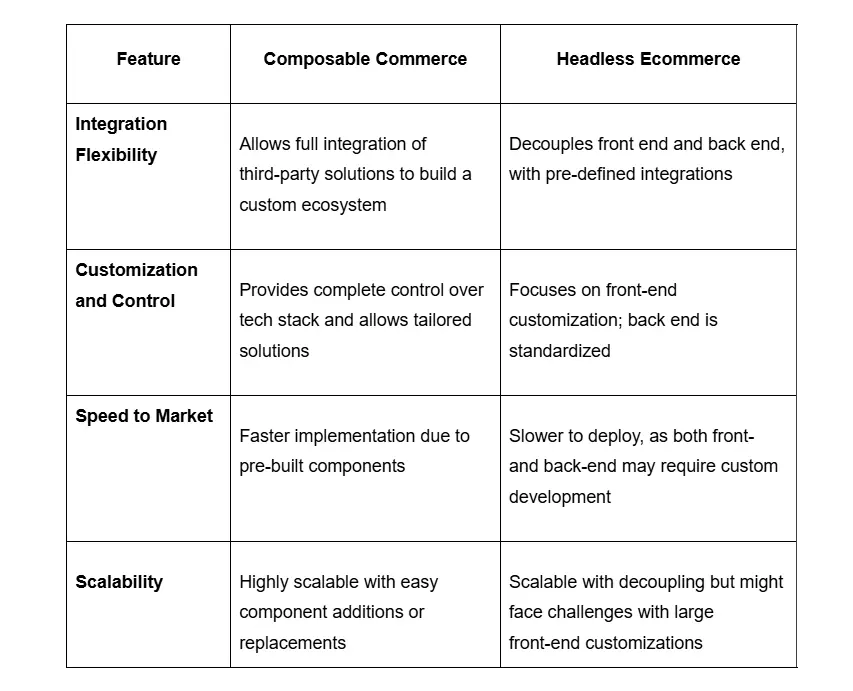Two of the most popular approaches to transforming how you manage your ecommerce approach are Composable Commerce and Headless Ecommerce. While both offer flexibility and customization, they differ in how they structure and manage digital experiences.
In this guide, we'll explore the key differences between Composable Commerce and Headless Ecommerce, highlighting their advantages and when each is most suitable for your business.
What is composable commerce?
Composable Commerce architectures empower you to choose individual components, like payment gateways, product management systems, or content management systems (CMS) based on their features and compatibility with your specific business needs. Composable Commerce solutions give companies the ability to scale, adapt, and evolve their ecommerce ecosystems in response to changing market demands.
What is headless ecommerce?
On an ecommerce platform, the front end (the "head") is responsible for delivering the user interface, while the back end manages data and business logic. Headless ecommerce refers to a decoupled architecture where the front and back ends of an ecommerce platform are separated. This separation enables you to create customized front-end experiences using any technology or framework, while the back end remains focused on core functions such as product management, order processing, and inventory control.
Key differences between composable commerce and headless ecommerce
Composable and headless ecommerce are both flexible and modern approaches to commerce architecture, but they differ in structure and implementation. Let's explore some of the key distinctions between them.

Advantages of composable commerce
Composable commerce offers a range of benefits that make it a compelling choice if you’re looking for agility, customization, and scalability. Let's take a closer look at the key advantages.
Flexibility and customization
With composable commerce, you can build an ecommerce platform tailored to your business needs by integrating the best tools for each specific function. This provides a higher degree of flexibility and customization compared to traditional monolithic solutions.

Consider a niche subscription box startup that breaks its monolithic platform into modular, API‑first pieces for catalog management, recurring billing, customer analytics, and personalized marketing. Overnight, they can spin up a themed box builder that lets subscribers tailor their selections, roll out a loyalty points engine in under three weeks, and integrate a real‑time chat support widget without touching core code.
Future-readiness
As technology and customer expectations evolve, Composable Commerce enables you to quickly adapt. If a new tool or technology emerges, you can easily integrate it into the existing system without requiring a complete overhaul.
Imagine a cutting‑edge athleisure brand that starts with a simple online store but dreams bigger. By unbundling its commerce stack into modular services, it can instantly plug in a voice‑activated shopping assistant for smart speakers, test an AR “try‑on” widget for mobile apps, and spin up a pop‑up kiosk integration in a week.
Since they’re composable, they’re able to quickly adapt and change, integrating new features and deploying them fast.
Best-in-class solutions
Composable Commerce allows you to use best-in-class solutions for each function. This ensures you’re getting the best fit for every aspect of your ecommerce ecosystem, from payments to marketing automation.
Improved time to market
When composable commerce is approached effectively, you can significantly reduce the time required to launch your ecommerce solutions, enabling you to respond faster to market changes and customer demands. Take care, though: complex, fully-composable solutions can actually take longer and cost more to implement.
Advantages of headless ecommerce
Headless ecommerce architectures can also have several key advantages, particularly for businesses looking for flexibility in user experience and innovation across multiple digital channels, while still requiring a more stable back-end system.
Complete control over user experience
Headless ecommerce gives businesses full control over their front-end design and customer experience. This allows them to create highly personalized and seamless experiences.
Multi-channel capabilities
With headless ecommerce, businesses can deliver consistent experiences across multiple channels. The decoupled architecture gives companies the power to create custom interfaces for various devices and platforms without affecting the back-end infrastructure.

When to choose each approach
Both Composable Commerce and Headless Ecommerce have their unique advantages, and the choice between the two depends on your business needs and objectives. If your business requires a highly customized and flexible ecommerce platform with the ability to integrate various third-party solutions, Composable Commerce might be the best choice. It's ideal for businesses that want to stay agile, adapt quickly to market changes, and create a tailored solution.
On the other hand, if your primary focus is on delivering a seamless, personalized user experience across multiple digital touchpoints while maintaining a robust back-end system, Headless Ecommerce is a great option. It's perfect for businesses that prioritize front-end innovation and need to scale across different channels.
For example, VTEX can help you become Composable with a platform that helps you choose and compound our native features and third-party ones. You can select and orchestrate different technologies to create a modern, agile, powerful, and robust infrastructure.
We have numerous combinations of native services, extensions, add-ons, integrations, and so on. When you use VTEX as your main ecommerce engine, you have freedom to add as many components and modules as needed to upgrade each part of your ecommerce—search, user interface (UI), etc.
At VTEX, we offer both Composable Commerce and Headless Commerce solutions to help businesses stay ahead and contend in the market. Discover how VTEX can support your ecommerce strategy.
